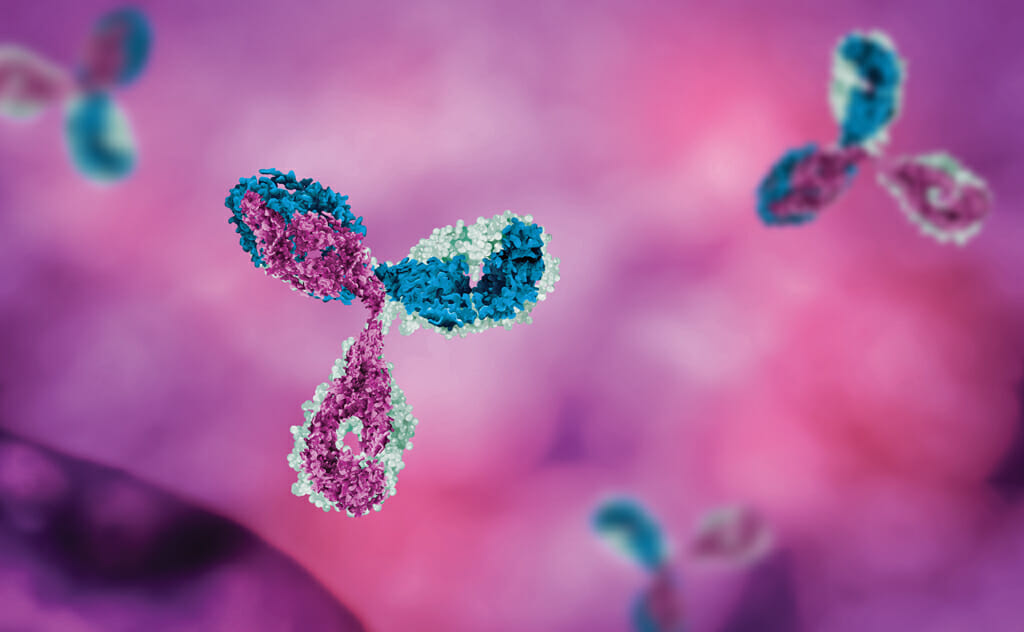After a year filled with change and uneasiness about the future — as witnessed by the pushback to the Inflation Reduction Act’s groundbreaking decision to allow Medicare to negotiate pricing on certain drugs — pharma has its sights trained on the future. The industry is brimming with optimism about another year of highly material readouts and practice-changing approvals in a number of key therapeutic areas.
In terms of market potential, 2024’s most anticipated approval is Lilly’s tirzepatide for obesity. Already marketed for diabetes, the drug could hit $14 billion in obesity sales alone by 2030.
In neurology, Alzheimer’s disease remains very much under the spotlight — and this time, it isn’t all about Biogen.
Eli Lilly expects an approval for its beta-amyloid-targeting donanemab, which yielded applause-worthy Phase III results. All eyes will be on its launch and, especially, the inevitable competition with Biogen/Eisai’s recently approved Leqembi.
The MS field is set for a stream of pipeline news from the novel BTK inhibitors class. Merck’s evobrutinib for relapsing MS is on track to deliver much-anticipated Phase III data in late 2023, while Sanofi expects a readout on tolebrutinib sometime in 2024. The highly anticipated BTK inhibitors (or newly named agammaglobulinemia tyrosine kinase inhibitors) aim to add a new and compelling mechanism of action (MOA) to the MS armamentarium.
Hemophilia continues to be a focus of top drug developers, with three big approvals pending for non-factor therapies. Sanofi’s fitusiran, Pfizer’s marstacimab and Novo Nordisk’s concizumab may well vie to displace drugs that offer similar advantages. Each offers efficacy in both hemophilia A and B, subcutaneous delivery, and extremely high efficacy with respect to bleeding rates. They will also be the first treatments applicable to patients with hemophilia B with factor IX inhibitors — who, up until now, have not had a viable treatment option. It will be interesting to watch how the three pharma giants choose to differentiate their products.
Immunology continues to generate important milestones for drugs with unique and differentiated MOAs. Amgen and Kirin have much anticipated data awaited in 2024 for rocatinlimab in atopic dermatitis. Merck awaits further data updates for its promising mAb, PRA023 for inflammatory bowel disease (both Crohn’s and ulcerative colitis). Meanwhile, after initial hype and lengthy Food and Drug Administration delays, UCB hopes to see bimekizumab (Bimzelx) approved and launched in the U.S. for psoriasis.
The oncology field continues to expand the armamentarium for underserved cancer subgroups. Astellas expects its first-in-class drug zolbetuximab to be approved for HER2 negative gastric cancer patients. AstraZeneca anticipates Phase III updates and regulatory plans in 2024 for datopotamab deruxtecan (Dato-DXd) in non-small cell lung cancer. Geron, for its part, is hoping to secure the company’s first FDA approval since its founding in 1990, with imetelstat for myelodysplastic syndromes.
Respiratory is set to see important additions and updates to existing marketed options. Verona expects an approval decision for its PDE 3/4 inhibitor ensifentrine following “compelling” data as an add-on to traditional LABA/LAMA drugs for COPD patients. GSK’s depemokimab awaits Phase III data for its semi-annually administered, long-acting biologic for severe asthma.
Then there’s Moderna, hoping to secure approval for its mRNA-based RSV vaccine. Pfizer and GSK both received an FDA thumbs-up for their RSV vaccine approvals in 2023.
As for drugs that treat rare conditions, Novartis’ iptacopan for paroxysmal nocturnal hemoglobinuria (PNH) may well be approved before the calendar turns to 2024. Some analysts believe it represents a more attractive option over AstraZeneca’s blockbusters Soliris and Ultomiris.
Finally, in psychiatry, Karuna aims to launch its schizophrenia drug KarXT in 2024. It potentially brings a new formulation and MOA to underserved patients — and, in the process, could reduce negative effects seen with standard-of-care antipsychotics.
Agents profiled in this report were chosen in consultation with experts from InThought Research and Ipsos as well as research platforms Adis Insight and Mindgram. Analyses of featured products include clinical data, revenue forecasts, expected launch dates and likelihood of success, updated as of August 31.

NEUROLOGY
Drug: Donanemab
Company/stage: Eli Lilly, pre-reg
Indication: Alzheimer’s disease
Clinical trial data: Donanemab is an amyloid-beta targeting mAb. Data from the Phase III TRAILBLAZER-ALZ 2 study showed 47% of participants on donanemab showed no cognitive decline at one year, compared to 29% on placebo (p<0.001). The incidence of amyloid-related imaging abnormalities (ARIA) was seen in 37% of patients, versus 15% on placebo. An FDA approval decision is expected late 2023.
InThought comment: “Donanemab appears to work best in patients with intermediate to low levels of tau tangles, which could be a niche differentiator to Biogen’s Leqembi — though measuring tau will be difficult based on cost and access to tau PET. Donanemab’s three deaths linked to ARIA may be a prescribing deterrent as physicians will face difficulties screening higher-risk patients. Lilly’s U.S. infrastructure might give donanemab an edge, but overall uptake is expected to be similar to Leqembi: slow in the first year due to accessibility and infrastructure requirements.” — Leon Henderson-MacLennan, medical adviser
Ipsos comment: “Lilly released Phase III results establishing close competition with Leqembi. Donanemab’s relative slowing of cognitive and functional decline looks promising, and the convenience of its finite dosing schedule is likely to be a big draw. However, the risk of developing ARIA and suitability only for mild cognitive impairment and mild AD are potential hurdles. Lilly will need to advocate for infrastructure, mindset changes and fast adoption of biomarker testing.” — Simone Gabriele, director, global therapy monitors
Sales estimate: $6.7 billion by 2030 (Credit Suisse)
Drug: Evobrutinib
Company/stage: Merck, Phase III, pre-reg
Indication: Multiple sclerosis (relapsing)
Clinical trial data: Evobrutinib is an orally administered, bruton tyrosine kinase (BTK) inhibitor. Extension Phase II data showed that out of the 73% (n=155) of patients completing 228 weeks of treatment, the annualized relapse rate (ARR) was reduced from 0.18 to 0.10 after switching to the 75 mg dose twice a day. The April 2023 Phase III partial clinical hold, due to liver toxicity concerns, has limited impact on timelines to deliver data in late 2023.
InThought comment: “Earlier Phase II data confirmed that evobrutinib reduced neurofilament light chain (the biomarker NfL) levels up to week 144. At AAN, it became clearer that such reduction was associated with improved MRI- and relapse-based outcomes, improving the probability of approval. Many trialists believe, pending further validation, the correlative data improved NfL’s position as a prognostic marker of disease activity and a surrogate marker of therapeutic effect.” — Henderson-MacLennan
Ipsos comment: “Evobrutinib is the first drug in the novel BTKi class, which are potentially more effective at slowing disability accumulation when compared to approved therapies. Liver toxicity signals appear to be a class-wide effect, asymptomatic in nature and reversible — and, therefore, unlikely to cause major concern. The Phase III readout anticipated later this year should clarify whether evobrutinib can compete with the big hitters in the market, the anti-CD20s.” — Sandra Teoh, senior research manager, global therapy monitors
Sales estimate: $1.3 billion by 2030 (Credit Suisse)
Drug: Tolebrutinib
Company/stage: Sanofi, Phase III
Indication: Multiple sclerosis (relapsing and progressive)
Clinical trial data: Tolebrutinib is also an oral BTK inhibitor. Long-term Phase IIb findings through 120 weeks showed an elicited dose-dependent reduction (more than 85%) in new gadolinium-enhancing T1 and new/enlarging T2 lesions in participants with relapsing MS. Tolebrutinib suffered a similar partial clinical hold to Merck, and study protocols were revised to improve monitoring frequency and enrollment criteria. A Phase III readout is expected in 2024.
InThought comment: “Tolebrutinib’s Phase II standalone MRI- and relapse-based outcomes improve the agent’s Phase III readout and approval prospects. A point of interest are preclinical data showing possible potency and durability advantages when compared to evobrutinib and Roche’s fenebrutinib in laboratory experiments and in non-human primate research.” — Henderson-MacLennan
Ipsos comment: “Tolebrutinib’s investigation for both relapsing and progressive MS provides a differentiating factor versus evobrutinib, as does its suspected greater CNS penetration and, therefore, likely stronger impact on disability progression. While this is the greatest unmet need in MS, time will tell if neurologists’ mindset can be shifted away from traditional inflammatory outcome measures.” — Teoh
Sales estimate: $2.2 billion by 2030 (Credit Suisse)

HEMATOLOGY
Drug: Fitusiran
Company/stage: Sanofi/Alnylam, pre-reg
Indication: Hemophilia A and B
Clinical trial data: Fitusiran is a small interference RNA therapeutic in development as a prophylactic for hemophilia A or B, irrespective of inhibitor use. Phase III results showed the once-monthly subcutaneous injection reduced annualized bleeding rates (ABR) by 90% (p <0.0001) compared to control arms, showing a statistically significant and clinically meaningful improvement in bleeding episodes versus on-demand treatments.
InThought comment: “The Phase III results showed a huge drop in ABR with many patients ending up with a bleeding rate of zero. As this is a silencing RNA and not a protein, the drug can be dosed infrequently — up to every two months, as a subcutaneous self-administered therapy. This is a big pro for Fitusiran versus SOC factor prophylaxis. How this fits in the treatment paradigm alongside other new and novel hemophilia drugs remains uncertain, but that also makes this space very exciting.” — Sam Leach, senior analyst
Ipsos comment: “Fitusiran’s once-monthly subcutaneous administration will help the drug to distinguish itself from available treatment options and competing pipeline therapies by providing hemophilia patients with an effective therapy at a lower treatment burden.” — Aine Kyle, research director, global therapy monitors
Sales estimate: $478 million by 2030 (Credit Suisse)
Drug: Marstacimab
Company/stage: Pfizer, pre-reg
Indication: Hemophilia A and B
Clinical trial data: Marstacimab is a monoclonal antibody targeting tissue factor pathway inhibitor (TFPI). Phase III results demonstrated a 92% reduction in ABR. Marstacimab also demonstrated superiority compared to SOC prophylaxis, with a 35% reduction in ABR.
InThought comment: “Pfizer has only released top-line data, but the bleeding episodes reported per year may be an improvement over SOC. One thing to note about non-factor therapies such as marstacimab is the thromboembolism risk. As the drug is manipulating the clotting factor pathway, it might be overdoing it and clotting too much. Other hemophilia drugs, such as fitusiran and concizumab, have had thromboembolism reports, but they adjusted dosing successfully. However, marstacimab so far has shown no thromboembolic events. This may indicate a major safety differentiator, assuming this is confirmed by the full data set.” — Leach
Ipsos comment: “Marstacimab’s subcutaneous administration will be seen as a favorable alternative to current intravenous treatment options and its once-weekly dosing will set it apart from Novo Nordisk’s concizumab, which is administered daily. Expected delays to concizumab’s U.S. launch may provide marstacimab with an opportunity to gain a foothold in this market and drive its uptake in hemophilia patients.” — Kyle
Sales estimates: $1 billion by 2030 (Credit Suisse)
Drug: Concizumab
Company/stage: Novo Nordisk, pre-reg
Indication: Hemophilia A and B
Clinical trial data: Concizumab is mAb, anti-TFPI. Phase III results showed an 86% reduction in treated spontaneous and traumatic bleeds when on concizumab prophylaxis, with an estimated mean ABR of 1.7 versus 11.7 with no prophylaxis. The company received a complete response letter (CRL) from the FDA requesting additional information on monitoring, dosing and manufacturing; Novo Nordisk is planning to complete its re-submission by the end of 2023. Concizumab is already approved in Canada and Australia.
InThought comment: “Previous reports of thromboembolic events, plus the CRL from the FDA, may give some practitioners pause to prescribe this drug over other therapies. It also has the disadvantage of requiring daily administration. However, the drug utilizes Novo Nordisk’s easy-to-use and mostly painless injection devices, which may make it a favorite for patients who struggle with injection site pain when using other therapies.” — Leach
Ipsos comment: “Concizumab’s subcutaneous administration is a welcome alternative to the intravenous therapies that control the hemophilia market. However, concizumab faces stiff competition from Pfizer’s marstacimab and a recent FDA request for more information may lead to further U.S. launch delays.” — Kyle
Sales estimate: $480 million by 2030 (Credit Suisse)

IMMUNOLOGY
Drug: Rocatinlimab
Company/stage: Amgen/Kirin, Phase III
Indication: Atopic dermatitis
Clinical trial data: Rocatinlimab is an immunomodulating anti-OX40 mAb. In its Phase II trial, it demonstrated a significant reduction in IgE concentrations below baseline by week 16 (p=0.0005), which continued into week 26 and maintained until week 56 (off-treatment for 20 weeks). Phase III data is expected in 2024.
InThought comment: “Experts are really excited about rocatinlimab, as OX40 is ‘the new kid on the block’ in terms of targets for atopic dermatitis. The landscape of mechanisms for this indication isn’t as broad as it is for others, like psoriasis. The Phase II data suggest good durability and disease modification, and the drug is being evaluated as a once-monthly dosing, which would be attractive to patients.” — Amanda Weyerbacher, senior principal
Ipsos comment: “With its unique MOA, there is much anticipation over the long-term response demonstrated in trials. The maintained reduction in IgE at week 56 indicates sustained efficacy among patients who had terminated treatment. As this initial read of data signals the potential to go beyond treating the disease and to consider disease modification, successful entry to the market could represent a milestone in AD treatment.” — Hannah Brown, associate director, global therapy monitors
Sales estimate: $1.7 billion by 2030 (Credit Suisse)
Drug: PRA023/MK7240
Company/stage: Merck/Prometheus, Phase III
Indication: Inflammatory bowel disease (ulcerative colitis and Crohn’s disease)
Clinical trial data: PRA023 is an anti-TL1A targeting mAb. Phase II UC results showed 26.5% of patients on PRA023 achieved clinical remission compared to 1.5% of patients on placebo at week 12 (p<0.0001). The Phase IIa CD trial showed a 26.0% endoscopic response and 49.1% clinical remission rates (p=0.002).
InThought comment: “Phase III trials are scheduled to start in 2023 and we should at least see some interim data in 2024. PRA023 is in a completely new class of drugs, with a new mechanism being evaluated in IBD. Phase II data were extremely encouraging with potential in both ulcerative colitis and Crohn’s disease. Its companion diagnostic (CDx), which is a genetic screen based on TL1-A to identify patients more likely to respond, represents an exciting area of precision medicine for IBD.” — Weyerbacher
Ipsos comment: “PRA023 is under the limelight following Merck’s sizable acquisition of Prometheus in 2023, while its companion diagnostic (CDx) also helps set it apart in the IBD pipeline. Though still in early development, Phase II results are promising and, if approved, the CDx will pave the way for biomarkers to be used routinely to stratify IBD patients, enabling more personalized treatment planning.” — Penny Robinson, research manager, global therapy monitors
Drug: Bimekizumab (Bimzelx outside the U.S.)
Company/stage: UCB, pre-reg (U.S.)
Indication: Moderate-to-severe psoriasis
Clinical trial data: Bimekizumab is an mAb targeting interleukin-17 (IL17), suppressing both IL17-A and IL17-F. After an initial PDUFA date in October 2021, the drug’s U.S. approval has been delayed due to manufacturing queries and site inspections. The most recent BLA resubmission was accepted by the FDA in December 2022. Three successful Phase III trials showed superior skin clearance at week 16 versus both placebo and AbbVie’s Humira.
InThought comment: “While Bimzelx is approved in Europe, Canada and Australia, the U.S. market is key and its delay there has puzzled many in the industry. The drug showed a great duration of response and PASI scores are extremely high, making this a strong contender in a crowded psoriasis landscape. The dual blockade of IL17A and IL17-F also offers a new mechanism versus current market competitors. We expect the resubmission to be sufficient for a U.S. approval in late 2023.” — Weyerbacher
Ipsos comment: “Unlike Novartis’ Cosentyx (secukinumab) and Eli Lilly’s Taltz (ixekizumab), which exclusively target IL-17A, Bimzelx inhibits both sub-units A and F. Label expansions in June 2023 for treating active psoriatic arthritis and axial spondyloarthritis highlight Bimzelx’s wider scope beyond skin issues. Despite initial FDA approval hurdles, we anticipate a positive UCB resubmission outcome, offering U.S. HCPs another armamentarium option to benefit many psoriasis patients.” — MamTing Thoo, research manager, global therapy monitors
Sales estimate: $1.2 billion ($800 million in the U.S.) and $2.4 billion (includes all indications) by 2030 (Credit Suisse)

ONCOLOGY
Drug: Zolbetuximab
Company/stage: Astellas, pre-reg
Indication: HER2-negative, locally advanced gastric or gastroesophageal junction (GEJ) cancer
Clinical trial data: Zolbetuximab is a first-in-class Claudin18.2 targeted mAb added onto capecitabine and oxaliplatin (CAPOX) or mFOLFOX6. Approximately 38% of first-line gastric cancer patients are expected to have the CLDN18.2 mutation. Data from its Phase III GLOW study (as an add-on to CAPOX) showed median PFS reached 8.21 months for patients assigned to zolbetuximab plus CAPOX compared with 6.80 months for patients assigned to placebo plus CAPOX. This translates to a 31% reduction in the risk of disease progression or death. The results bolstered findings in the other SPOTLIGHT study (as an add-on to mFOLFOX6).
InThought comment: “Since few targeted therapies are available for HER2-negative patients, it will be exciting to see Astellas open up this new patient subset in a difficult-to-treat tumor type where relatively few other CLDN18.2-
targeting assets exist in clinical development. As Astellas is well prepared for a successful global launch, it is also attempting to expand zolbetuximab’s reach with trials ongoing in later-line gastric cancer and first-line pancreatic cancer.” — Ashley Ingles, senior analyst
Ipsos comment: “In the SPOTLIGHT and GLOW trials, zolbetuximab combined with CAPOX or FOLFOX demonstrated greater efficacy compared to traditional chemotherapy alone. Real-world data will determine the effectiveness of the new combination regimen versus the recently approved Keytruda (Merck) and Opdivo (BMS).” — Alessandra Franceschetti, senior director, global oncology monitor
Sales estimate: $500 million by 2030 (Credit Suisse)
Drug: Datopotamab deruxtecan (Dato-DXd)
Company/stage: AstraZeneca/Daiichi Sankyo, Phase III
Indication: Non-small cell lung cancer (NSCLC)
Clinical trial data: Datopotamab deruxtecan (Dato-DXd) is a TROP2-directed antibody drug conjugate (ADC). Initial Phase III results demonstrated statistically significant improvement of progression-free survival (PFS) compared to SOC docetaxel in patients with locally advanced or metastatic NSCLC treated with at least one prior therapy. Mature OS data are awaited. The safety profile is consistent with previous trials, including events of interstitial lung disease (ILD) and some Grade 5 (fatal) events. Updates on data and regulatory plans are anticipated in 2024.
InThought comment: “Following success in solid tumors and Pfizer’s planned acquisition of Seagen, interest in ADC is increasing. Approval of this novel ADC in a relatively broad NSCLC indication is significant. That said, there was no confirmation of a statistical overall survival difference and there is concern surrounding deaths associated with ILD, leaving some uncertainty.” — Ingles
Ipsos comment: “While few details were provided in the topline readout for TROPION-Lung01, the financial market reacted negatively due to fears that these results were not clinically meaningful, and safety may be an issue due to some ILD deaths. This has given Gilead’s Trodelvy breathing room in advance of its own lung trial results. Trodelvy has a well-characterized safety profile from trials (and real-world evidence) in breast cancer, and ILD has not been noted.” — Eric Blouin, SVP, oncology
Sales estimate: $3.4 billion (NSCLC)/$8.8 billion (includes all indications) by 2030 (Credit Suisse)
Drug: Imetelstat
Company/stage: Geron, pre-reg
Indication: Myelodysplastic syndromes (MDS)
Clinical trial data: Imetelstat is a first-in-class intravenous telomerase inhibitor positioned for low- or intermediate-1-risk MDS. The Phase III IMerge trial — the basis of Geron’s July NDA submission — met the primary endpoint of eight-week transfusion independence (TI): 39.8% imetelstat versus 15% placebo. The median TI duration approached one year, and with increased mean hemoglobin levels, compared to placebo.
InThought comment: “With disease-modifying activity in certain patient subsets, imetelstat will challenge the only other marketed compound in transfusion-dependent LR-MDS, luspatercept. Imetelstat is also able to treat both RS+ and RS- patient subtypes. Geron is messaging Imetelstat selectively for malignant cells, with upregulated telomerase.” — Lavan Khandan, senior principal
Ipsos comment: “Imetelstat was built upon discoveries that expanded the understanding of the role of telomeres in highly proliferative diseases, such as cancer, and Geron is vying for its first drug approval since its founding in 1990. Imetelstat’s positioning is complicated by BMS’ Reblozyl, which has demonstrated success in frontline disease. Competitive intensity will increase in this area of great unmet need.” — Elizabeth Machado, SVP, healthcare (U.S.)
Sales estimate: $600 million by 2020 (Credit Suisse)

RESPIRATORY
Drug: Ensifentrine
Company/stage: Verona, pre-reg
Indication: COPD
Clinical trial data: Ensifentrine is an inhaled small molecule, long-acting, dual phosphodiesterase (PDE) 3/4 inhibitor. In its two pivotal Phase III ENHANCE trials, statistically significant improvement in lung function was achieved. The drug reduced moderate to severe exacerbations versus placebo at 24 weeks (p=0.050) and 48 weeks (p=0.009). An NDA was submitted to the FDA in June 2023.
InThought comment: “Ensifentrine has a compelling triple-threat MOA designed to address a massive unmet need. Data are compelling, as they were generated in cohorts with a significant amount of background LABA/LAMA use. It’s important to have a novel agent that can be seen as an important add-on to today’s classic LAMA/LABAs. In ENHANCE-1, it’s notable that ensifentrine significantly reduced rescue medication use at weeks six and 12. This looks like a formidable, new entrant barring unforeseen or late red flags, while so far the safety and tolerability profiles appear acceptable.” — Henderson-MacLennan
Ipsos comment: “Verona Pharma’s ensifentrine could play an important role in COPD management. Currently, roflumilast, which was approved in 2011, is the only available PDE4 inhibitor. Besides modulating inflammation through PDE4 inhibition, ensifentrine’s PDE3 inhibiting action provides the additional benefit of improved bronchodilation, and its inhalation administration reduces systemic side effects.” — Michelle Tan, associate director, global therapy monitors
Drug: mRNA-1345
Company/stage: Moderna, pre-reg
Indication: RSV
Clinical trial data: mRNA 1345 is a prophylactic RNA vaccine for the prevention of RSV. mRNA-1345 demonstrated vaccine efficacy of 83.7% against RSV defined by two or more symptoms in older adults, while the vaccine was generally well tolerated (injection site pain, fatigue, headache myalgia, arthralgia). Severe adverse events were 4% versus 2.8% in placebo. In July, Moderna announced global submissions for approval in adults 60+; the company has U.S. fast-track designation.
InThought comment: “With both J&J and Bavarian Nordic out of the RSV vaccine race, this leaves Moderna as the next major competitor to Pfizer and GSK, who received historic first approvals for their RSV vaccines in May 2023. Moderna’s vaccine is more differentiated with its mRNA technology and high level of efficacy, which could drive uptake.” — Ingles
Ipsos comment: “mRNA-1345 is expected to receive regulatory approval by the end of 2023, with its launch in 2024. Moderna offers expertise in mRNA technology and is widely recognized for its COVID-19 vaccine, which may influence company messaging and consumer sentiment with the RSV vaccine as it competes directly with GSK and Pfizer.” — Lindsey Sohl, director, syndicated global RSV study
Drug: Depemokimab
Company/stage: GSK, Phase III
Indication: Severe eosinophilic asthma
Clinical trial data: Depemokimab is a long-acting, anti-IL-5 mAb. In the initial 50-subject Phase I program, all depemokimab doses reduced blood eosinophil count (BEC) by 24 hours (≥44%) with a clear dose-ascending response up to 40 weeks (to the maximum tolerated dose). SWIFT-1 and 2 Phase III results are anticipated in H2 2024 while outcomes from NIMBLE — the comparative trial versus depemokimab, GSK’s Nucala, and AstraZeneca’s Fasenra — are expected the following year.
InThought comment: “The confluence of an appealing mechanism with validating pharmacodynamics, dosing convenience, good-sized eligible patient population and potential for significant label expansion really makes depemokimab one to watch. The asset’s appeal derives not only from its highly validated anti IL-5 mechanism but also its long-acting kinetics that allow for every-six-months subcutaneous dosing. In the absence of mid-phase trial data, its readout is a high-risk, high-reward proposition. But the degree to which eosinophil suppression correlates with asthma-specific, anti-inflammatory effects is relatively tight, and adverse effect and tolerability profiles are without red flags.” —
Henderson-MacLennan
Ipsos comment: “Despite multiple anti-IL-5 biologic options available for severe asthma, GSK’s depemokimab could be a game-changer. If approved, it would be the first semi-annually administered long-acting biologic. With Nucala’s patent nearing expiration, depemokimab emerges as a viable replacement for GSK in this market.” — Tan
Sales estimate: $848 million by 2030 (Credit Suisse)

OTHER
Metabolic Disorders
Drug: Tirzepatide
Company/stage: Eli Lilly, pre-reg
Indication: Obesity
Clinical trial data: Tirzepatide is a once-weekly GIP and GLP-1 receptor agonist. Already approved as Mounjaro for Type 2 diabetes, Lilly is seeking an additional, more lucrative label in obesity. Pivotal data coming from the SURMOUNT-1 trial showed 22.5% weight loss at 72 weeks in overweight or obese patients. With fast-track designation, an FDA approval is expected late 2023.
InThought comment: “Weight-loss figures from Lilly’s trials are pretty astounding. It will be going head-to-head with Novo Nordisk’s blockbuster Wegovy, which has had a market monopoly since 2021. Lilly enters into a market with high demand — which Novo has struggled to meet due to its own supply issues. Administrative and safety similarities to Wegovy, combined with larger weight-loss figures, will likely render tirzepatide the market favorite for obesity. However, there are concerns that weight loss is not all fat and at times includes muscle mass, which would not be beneficial for elderly patients. Long-term studies are needed to understand what happens to the weight if a patient stops the drug.” — Leach
Ipsos comment: “Tirzepatide is a much-anticipated obesity treatment with impressive efficacy resulting in a mean weight loss of 26%. Historically, doctors may have hesitated to prescribe anti-obesity medications (AOMs), but Novo Nordisk’s Wegovy has increased the dialogue between doctors and patients. Tirzepatide, showing superior efficacy amid Wegovy’s supply chain issues, has the potential to be a blockbuster, providing a solution to lifelong weight struggles and the prevention of obesity-related co-morbidities. Still, steady supply and savings programs are needed due to high demand and limited insurance coverage.” — Lindsay Weisker, senior qualitative strategist, U.S. healthcare
Sales estimate: $14 billion (in obesity)/$42 billion (includes all indications) by 2030 (Credit Suisse)
Rare Disease
Drug: Iptacopan
Company/stage: Novartis, pre-reg
Indication: Paroxysmal nocturnal hemoglobinuria (PHN)
Clinical trial data: Iptacopan is an orally available targeted factor B inhibitor of the alternative complement pathway, acting upstream of the C5 terminal pathway. Data from the APPOINT-PNH trial showed 98% of 40 patients achieving red blood cell transfusion independence at 24 weeks. This is in contrast to 70% of patients who needed it six months prior to treatment. In its Phase III 97-patient APPLY-PNH trial, data demonstrated superiority over anti-C5 therapy for PNH patients experiencing residual anemia despite prior anti-C5 therapy. An approval decision (with FDA breakthrough designation) is expected in late 2023.
InThought comment: “While AstraZeneca’s Soliris and Ultomiris — SOC administered as IV — are acting on a more terminal part of the complement pathway, iptacopan acts on the alternative pathway and appears better at suppressing hemolysis. While SOC takes care of one type of hemolysis, iptacopan acts further up the pathway to take care of both types of hemolysis, showing improvements in anemia and, most importantly, transfusion avoidance in patients. This, combined with its oral delivery, is sure to improve quality of life significantly versus SOC.” — Roshni Basu, senior principal
Sales estimates: $600 million (PNH)/$3.2 billion (includes all indications) by 2030 (Credit Suisse)
Psychiatry
Drug: KarXT (xanomeline-trospium)
Company/stage: Karuna, pre-reg
Indication: Schizophrenia
Clinical trial data: KarXT is an oral investigational M1/M4-preferring muscarinic agonist in development for treating schizophrenia. Its recent Emergent-3 Phase III trial was its third positive registrational trial, demonstrating an 8.4 reduction in PANSS total score compared to placebo at week five (p<0.0001). Most common treatment-emergent adverse events were gastrointestinal issues, headache, hypertension and insomnia. The company is preparing its NDA package for a potential launch in the second half of 2024.
InThought comment: “KarXT is well differentiated because of its mechanism and drug profile versus generic direct dopaminergic modulating antipsychotics. The mechanism and formulation reduce the risk of sedation, extrapyramidal and metabolic effects seen with SOC. There is also some evidence suggesting it could also be effective for negative symptoms, which would be a major differentiator from current options. The only thing that might delay approval is if the company decides to submit data from its Phase I ambulatory blood pressure study, which could trigger an extended FDA review. Karuna initiated the study after observing some slightly concerning hypertension side effects.” — Jasmine Lucas, senior analyst
From the October 01, 2023 Issue of MM+M - Medical Marketing and Media








